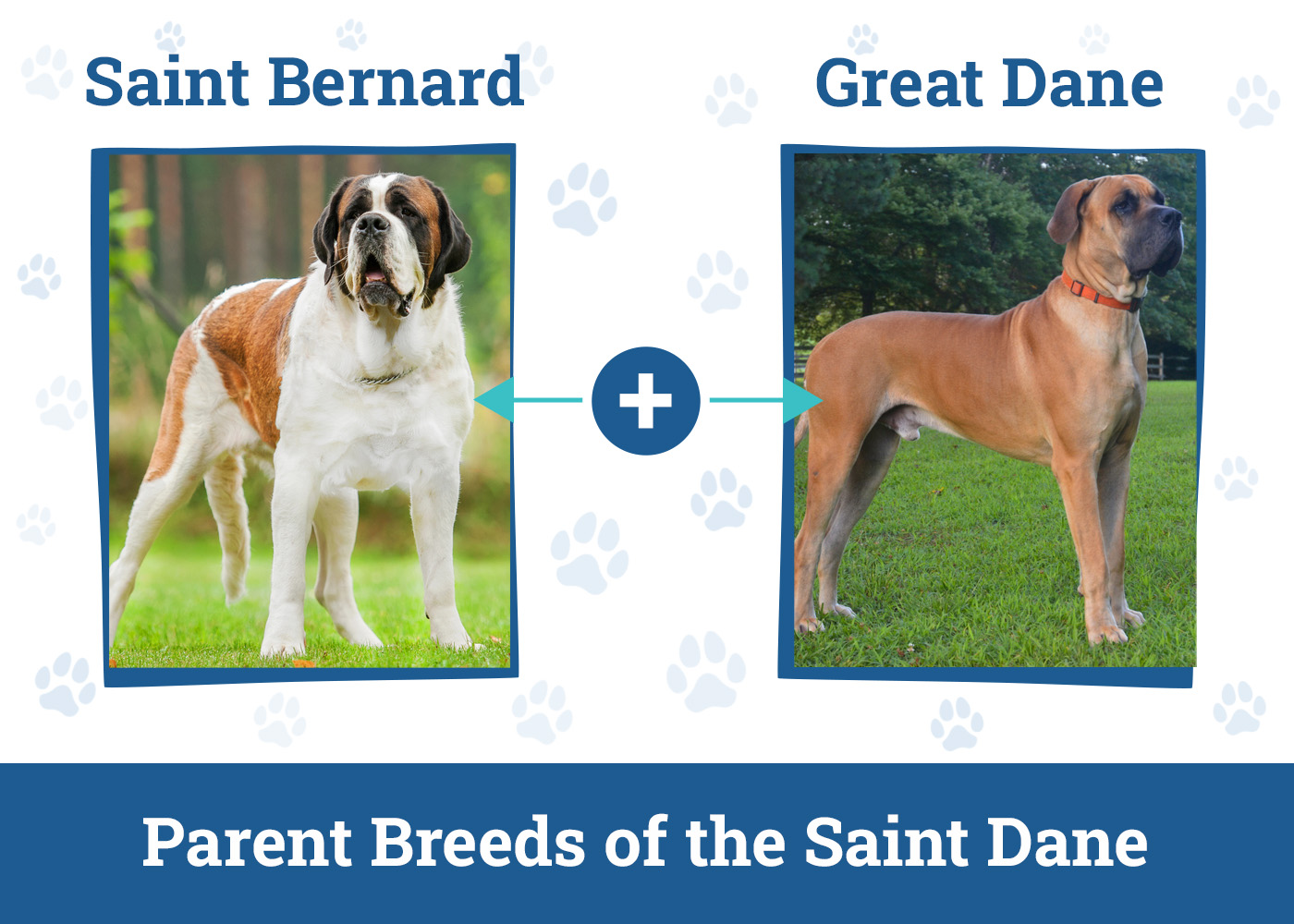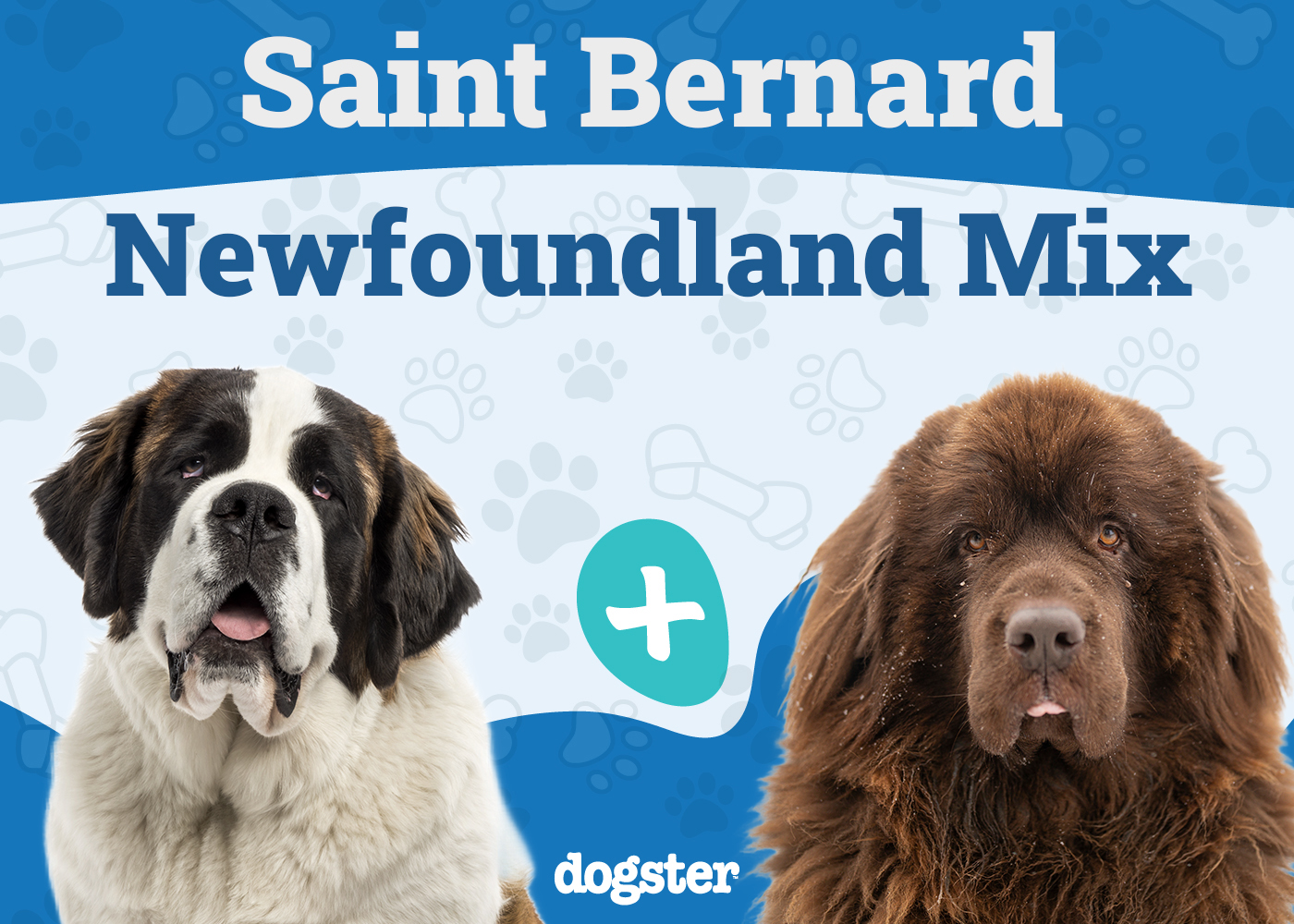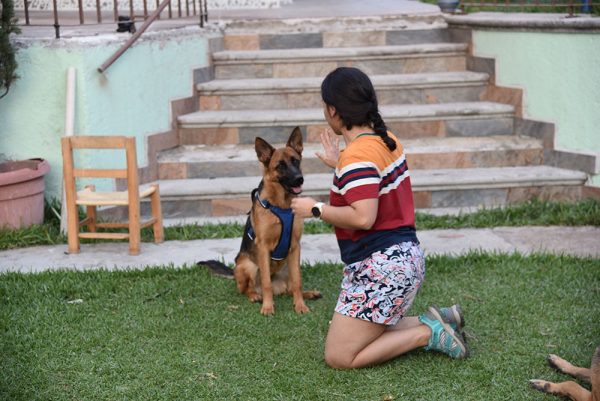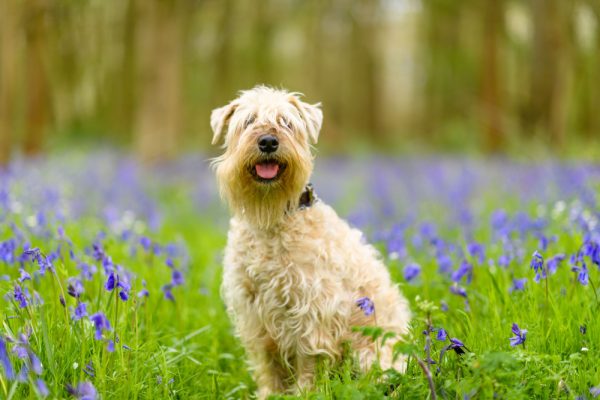In this article
View 8 More +Despite their intimidating size, Giant dogs are often incredibly friendly. As shown by their height, muscled body, and all that fur, the Saint Bernewfie is descended from two of the gentlest giants of the dog world, the St. Bernard and Newfoundland dog). They share the same peaceful temperament and are faultlessly loyal to their family members.
There’s more to these dogs than their sweet heart, however. They are large pets and need the right care to ensure that they’re healthy and happy. This guide will introduce you to Saint Bernewfie dogs and share a few tips for their care.
Breed Overview
Height:
25.5–30 inches
Weight:
100–180 pounds
Lifespan:
8–10 years
Colors:
Black, brown, red, black and white, brindle, mahogany, gray
Suitable for:
Active families, families with children, large families, houses with a yard, owners who don’t mind drooling dogs
Temperament:
Loyal, affectionate, stubborn, sensitive, dependable, protective, patient, fun-loving
A mix of the Saint Bernard and the Newfoundland, the Saint Bernewfie is a loyal designer breed with a sweet disposition. They’re huge dogs, but once you know how gentle they are, they become less intimidating. The Saint Bernewfie adores children and loves to spend as much time as possible with their family members.
With two heroic breeds in their ancestry, it’s safe to assume the Saint Bernewfie is destined for great feats of bravery too. No matter what heroics they get up to, they’ll always be ready for a cuddle at the end of the day.
Saint Bernewfie Characteristics
Saint Bernewfie Puppies
The Saint Bernewfie isn’t as expensive as the Saint Bernard or the Newfoundland, but they still cost a bundle to purchase, especially if you use a breeder. They’re not the easiest dogs to find either and are much rarer than their parents. While both the Saint Bernard and the Newfoundland are popular as individuals, their mixed puppies haven’t been around long enough to develop the same following.
That said, you can find breeders; there just might not be one near your area. You might find it especially challenging to find a Saint Bernewfie at a shelter or rescue, but it is also possible if you look in the right places.
As with all puppies, early obedience training and socialization for this breed are essential. They grow into big dogs that aren’t easy to manage when they misbehave. While they’re not an aggressive breed, they are strong and intimidating. You’ll need to teach them how to control themselves, especially on walks and around strangers.


Temperament & Intelligence of the Saint Bernewfie 🧠
Gentle and affectionate are two adjectives commonly ascribed to the Saint Bernard and Newfoundland. Their offspring shares this sentiment, which means the Saint Bernewfie is a massive lapdog that loves to be around people.
They are also eager to please, with a willingness to work as long as they can be alongside their family members. These dogs are sensitive, though, so you need to spend plenty of time with them and train them with firm leadership without harsh corrections.
The Saint Bernewfie isn’t demanding exercise-wise, though they do need plenty of opportunities to move around and play. They are sociable and aren’t suited to homes that are left empty for most of the day.
Are These Dogs Good for Families?🏡
One of the most loved traits of the Saint Bernard and the Newfoundland is how well both dogs get along with children. The Saint Bernewfie might also be huge and a bit intimidating, but they are a giant softy that adores children of all ages. You’ll need to supervise them with young children due to the dog’s size and strength, though. A puppy might not be trouble, but an adult Saint Bernewfie can easily knock over a young child without realizing it.
Their attachment to people also gives them a fondness for large families. They hate being alone and love cuddling with their favorite people. Big families that can spoil them with attention are a delight for these dogs. Don’t forget to walk your Saint Bernewfie regularly, and keep a towel handy to mop up their drool.
Does This Breed Get Along With Other Pets?
The Saint Bernewfie is a gentle dog that loves to be surrounded by friends. They need to be socialized properly due to their size, and this can help them become accustomed to other animals. Fortunately for multi-pet homes, the Saint Bernewfie gets along well with other dogs and cats.
That said, some pets might be intimidated by the Saint Bernewfie’s size, especially if you introduce an adult dog to your home. Always make sure to do introductions slowly, and monitor your pets’ progress before taking the next step.

Things to Know When Owning a Saint Bernewfie
Before you get a Saint Bernewfie, you should know about their care needs. Most of all, you need to ensure that you can afford to keep such a big dog throughout their lifetime. Paying attention to their food, healthcare, grooming, and exercise needs and training will ensure that you and your dog are happy for a long time.
Food & Diet Requirements
A Saint Bernewfie’s appetite is just as big as they are. It’s recommended that you feed them 4 cups of kibble a day or mix an appropriate portion of their kibble with wet food. These dogs are prone to developing conditions like bloat, so you should break up their meals into smaller portions to serve throughout the day and avoid exercise immediately before and after eating.
Always remember to adjust how much your dog eats based on their age, weight, and how active they are.
Exercise
Despite their size and past as working dogs, the Saint Bernewfie is quite content to spend the day cuddling. They are also more than happy to go on long hikes or take part in other activities.
While they don’t have boundless amounts of energy, they do need between 30 and 45 minutes of activity a day. Fortunately, these dogs are happy to go for walks, pull carts, or try their skills at agility, obedience, and tracking. Most Saint Bernewfies will also enjoy swimming due to their Newfoundland parent.
The activity that they love most, though, is spending time with you. They’ll happily try everything as long as you join in too!
Training
All dogs need training, but it’s even more important for large breeds like the Saint Bernewfie. They might be gentle and friendly, but their size and strength make them a force to be reckoned with when they don’t know the correct way to behave. Start training them from a young age to help prevent them from developing bad habits, and teach them how to manage their size and strength as they grow.
They can be stubborn, but they are also eager to please and sensitive, with a strong dislike of harsh corrections. Reward them with treats, stay consistent, and have fun. Don’t forget to introduce them to new people and places too. This is a friendly breed, but they can still become anxious in unfamiliar situations.
Grooming ✂️
You’ll need to brush your Saint Bernewfie at least once a week due to their thick double coat. This will help remove loose fur and prevent their coat from getting matted. They’ll shed throughout the year, and you will need to brush them daily during the shedding seasons twice a year. Depending on whether their Saint Bernard parent is long or short haired, the Saint Bernewfie can have short, medium, or long fur.
These dogs also have floppy ears, which can trap dirt, so remember to check them regularly and make sure they’re dry, especially after swimming sessions. Their claws and teeth will need tending to regularly.
Health and Conditions
As a large dog, the Saint Bernewfie isn’t a long-lived breed, but they are relatively healthy due to their mixed heritage. One of the most serious health issues that the Saint Bernewfie is susceptible to is bloat. This condition can be fatal if not caught and treated early. They can also inherit a few other health issues, such as joint dysplasia, overheating, heart conditions, allergies, and eye problems.
- Eye problems
- Skin allergies
- Bloat
- Hip dysplasia
- Elbow dysplasia
- Overheating
- Dilated cardiomyopathy
Male vs. Female
There are a few differences in temperament when it comes to male and female Saint Bernewfies. The females can be slightly more aloof and stubborn, while the males are more easily distracted and clumsier. Both are still big dogs, though, and they share the same friendliness and slobbery natures.
Take the time to meet your Saint Bernewfie before you bring them home. This will help you get to know their personality, so you can see if there’s a bond that you can build between you and how well the puppy or adult dog reacts to your presence.

3 Little-Known Facts About the Saint Bernewfie
The Saint Bernewfie is a relatively new hybrid breed, but they are descended from two older and well-established favorites of the dog world. While they might not have much history of their own, the feats of their ancestors prove that these dogs are likely to be just as heroic and beloved as their parents.
1. They Are Descended From Heroes
It’s hard to say when the Saint Bernewfie was first introduced, but their heritage will tell you what these dogs might excel at. Both the Saint Bernard and the Newfoundland are two of the most heroic dog breeds in the world.
The Saint Bernard was bred by Swiss monks at the Hospice of St. Bernard. As a haven for travelers of the Italian-Swiss mountain passes, the Hospice was also home to search-and-rescue teams who would seek out travelers who’d gotten lost on the trails. Over three centuries, the Saint Bernard helped save over 2,000 people.
Newfoundlands were no less successful in their rescuing efforts, though their skills lay in water rescue rather than mountain missions. With their webbed toes and strength, they quickly became known as the “Saint Bernard of the water” due to their skill in saving people from drowning. One Newfoundland in 1919 saved the lives of 20 shipwreck survivors by pulling the lifeboat to shore.
The Saint Bernewfie likely shares their parent breeds’ courage and is bound to be capable of remarkable bravery both on land and in the water
2. The Saint Bernewfie Can Be Excellent Swimmers
Thus far, there’s no official standard for the Saint Bernewfie, so there are often remarkable differences between individuals of the breed. One big difference is their enjoyment of water.
Saint Bernewfies that take more after the Newfoundland often share the same webbed toes and fierce love of water. These members of the breed are powerful swimmers and are just as likely to try to rescue you from the water as their ancestor.
3. They Drool Excessively
The one thing that you need to remember about the Saint Bernewfie is how renowned their parents are for their drooling. Owners of Saint Bernards and Newfoundlands always need to keep a towel handy to mop up puddles.
Since both breeds have this trait, it’s safe to say the Saint Bernewfie is just as loving and slobbery as their ancestors.

Final Thoughts
Descended from two of the most heroic dog breeds in the world, the Saint Bernewfie is a giant, droopy-eared softy. They also need plenty of attention to scratch their itch to be social. Fortunately, they adore large families and children. As long as they can spend time with you, they’re happy to laze about on the couch or take part in agility and obedience competitions, as well as cart-pulling, hiking, tracking, and doing all sorts of other canine jobs.
As their size suggests, these dogs do need to work. Don’t let the tiny puppies fool you into slacking off with their training. Early obedience training and socialization are essential if you want your Saint Bernewfie to grow up to be well-behaved. They also need at least 30–45 minutes of exercise a day and plenty of food to keep them going.
While they’re not cheap dogs or low maintenance, your Saint Bernewfie will reward your attention with loyalty, dedication, and plenty of slobbery kisses!




















